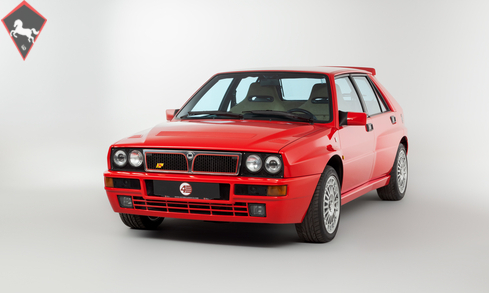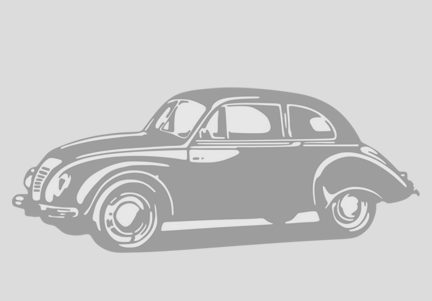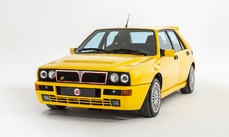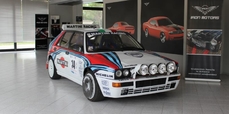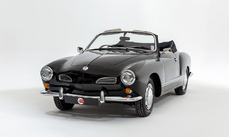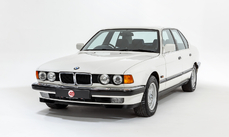Lancia Delta HF Integrale Evo II 1993
Allgemeine Beschreibung :
Model History
The Lancia Delta was a five-door hatchback designed by Giorgetto Giugiaro and released in 1979. It became one of the most successful rally cars ever, having won the World Rally Championship for manufacturers six times between 1987 and 1992. After the abolition of Group B rallying Lancia was forced, along with all other manufacturers, to compete with Group A cars. The 4-wheel drive Delta HF was therefore pressed into service for the 1987 season. Despite some flaws it was more suitable for rallying than its rivals and easily won the 1987 championship.
The Delta's dominance helped it out in the Italian market at least, where a 42% sales increase in the first half of 1987 was directly attributed to its rallying successes. Competitors began to emerge during 1988, in response to whom Lancia produced the Delta Integrale, and then in 1989 the Integrale 16v, which remained competitive until 1991 and netted the team four more world championships. The Integrale Evoluzione was introduced for 1992 and won the championship for a record sixth year in succession. Lancia drivers won the drivers' title in 1987, 1988, 1989 and 1991. The four evolutions of the Delta won 46 world championship events between them, and their run of six successive manufacturers' championships remains a world record.
The first Evoluzione cars were built at the end of 1991 and through 1992. These were to be the final homologation cars for the Lancia Rally Team, as the ‘catalytic’ Evoluzione II was never actually rallied by the factory. The Evoluzione I had a wider track front and rear than earlier Deltas. The boxy wheel arches were extended and became more rounded. The wings were now made in a single pressing. The front strut top mounts were also raised, which necessitated a front strut brace. The new Integrale retained the four-wheel drive layout but the engine was modified to produce 210hp at 5,750 rpm. Further external changes included new grilles in the front bumper to improve the air intake for engine compartment cooling, a redesigned bonnet with new lateral air slats to further assist under-bonnet ventilation, an adjustable roof spoiler above the tailgate, new five-stud wheels with the same design as the rally cars, and a new single exhaust pipe.
Presented in June 1993, the Evoluzione II version of the Delta HF Integrale – as featured here – was equipped with an updated version of the two-litre 16-valve turbo engine to produce more power. It also received a cosmetic and functional facelift that included new 16-inch alloy wheels, body-coloured roof mouldings, an aluminium fuel cap, air-intake grilles on the front mudguards, a red-painted cylinder head, and high-back Recaro sport seats. With ABS, fog lamps and Recaro seats now standard on all markets, the sole optional extra was air conditioning. The interior upholstery was always trimmed in beige Alcantara with diagonal stitching on seat centres and door panels, however additional colour and trim combinations were made available through a number of limited editions.
Equipment
Monza Red paintwork, Beige Alcantara upholstery, Recaro sports seats, 16-inch alloy wheels, 5-speed manual transmission, Air conditioning, Electric windows, PAS, ABS, Adjustable rear spoiler, Three-spoke leather Momo Corse steering wheel, ‘Final Edition’ quick shift kit, Full Ragazzon stainless steel exhaust including de-cat pipe (original exhaust system included), Spare 17-inch Speedline Corse alloy wheels, EU-spec headlights, Digital clock, Pioneer CD player, Central locking, Tailored HF carpet mats, Spare wheel with cover, Tool kit, Spare keys.
Exterior
This desirable Evo II presents beautifully in vibrant Monza Red. With its muscular box arches and adjustable rear spoiler, this low mileage example looks sensational against our studio backdrop. The lustrous paintwork maintains a deep and uniform shine throughout, with perfect panel fitment and no signs of any damage or corrosion to report. The lights are clear all round and free from any signs of moisture ingress, all the grilles are perfect, and there are no unsightly scuffs or scrapes to either of the bumpers. All in all, a highly impressive unrestored example that looks to have driven only half the mileage.
VIEWINGS WELCOME BY APPOINTMENT ONLY /// ADDITIONAL PHOTOS AVAILABLE UPON REQUEST
Interior
The deeply supportive Recaro seats are trimmed in soft beige Alcantara with the correct diagonal centre stitching. The upholstery remains in excellent original condition throughout with no marking and only some expected surface wear to report. The rear seats look especially fresh and appear to have been hardly used. Glancing across the dash, fascia, and centre console everything looks great with no sun damage or wear to the plastics, and in the footwells the carpets are protected by a set of tailored HF overmats. Pleasingly the original Momo Corse steering wheel is still fitted, the only upgrades over standard being a handy CD player and the Final Edition-style quick shift kit with carbon fibre surround.
ENGINE & TRANSMISSION
The tightly packed engine bay presents really well. There are no signs of any damage or previous poor repair, and all the components appear in excellent condition including the red cam cover that’s free from any wear. Since arriving with us the car has been fully inspected, road tested, and has just been fitted with a new clutch for the next keeper’s peace of mind. The most recent service was carried out in June 2022 at 70,021 miles; a rolling road power run completed at the same time shows the engine to be producing a healthy 210hp at 5,860rpm. The cambelt was last changed in March 2021 at 68,563 miles; this work was carried out by Zagato Lancia in London.
WHEELS, TYRES & BRAKES
The Evo II sits on the correct 16-inch alloy wheels, all in perfect unmarked condition with Lancia centre badges. They are shod in a matching set of Dunlop tyres with ample tread left at each corner. The brakes have also been checked and remain in fine operational condition, bringing the car to a stop quickly and in a straight line; new front discs and pads have just been fitted at the current mileage.
History File
This rust-free example was imported from Japan in 2011 with a fully documented 66k miles under its belt. It has now driven a total of 70k miles (112,882km) and has seen only 4 UK owners. The accompanying History File includes the original Lancia document wallet with all owner’s manuals, the service booklet, and a raft of specialist maintenance invoices from its time in the UK. At the current mileage, the car has received a new clutch and new front brakes. It was most recently serviced in June 2022 and the cambelt was last changed in March 2021. Other recent spends include a full Ragazzon stainless steel exhaust – which sounds absolutely fantastic – and a set of 17-inch Speedline Corse rims and tyres. The car is currently fitted with the original 16-inch wheels but the Speedlines are included, as is the original exhaust system. The MOT is valid until June 2023.
http://www.4starclassics.com/for-sale/lancia-delta-hf-integrale-evo-2-for-sale/
1993 Lancia Delta HF Integrale Evo II is listed verkauft on ClassicDigest in Kingsley by 4 Star Classics for £79995.
Fakten der Auto
Karosserietyp : Auto Marke : Lancia Modell : Delta Ausführung : HF Integrale Evo II Hubraum : 2.0 Modelljahr : 1993 Karosstyp : Pick up Lage : Hampshire
Verkauft
Angaben Zum Verkäufer
Verkauft
People who viewed this Lancia Delta also viewed similar Lancia listed at ClassicDigest
Other cars listed for sale by this dealer
über Lancia
Ah, Lancia, die italienische Marke, die auf dem schmalen Grat automobiler Brillanz getanzt hat! Lass mich dich auf eine Reise durch die fesselnde Geschichte von Lancia mitnehmen, einer Marke, die Leidenschaft, Innovation und Rallye-Erfolg verkörpert.Akt 1: Die Frühen Jahre (1906-1920er)
Lancia wurde 1906 von Vincenzo Lancia gegründet, einem Ingenieursgenie mit einer Vorliebe für das Außergewöhnliche. Die Marke erlangte schnell einen Ruf für ihre präzise Ingenieurskunst und innovative Herangehensweise. Der Lancia Alpha, 1907 eingeführt, war das erste Auto mit einem schmalen V4-Motor und setzte den Ton für Lancias Einsatz für technische Exzellenz.
Akt 2: Innovation im Zentrum (1930er-1950er)
Die 1930er Jahre sahen Lancia die Grenzen der Innovation mit Modellen wie dem Lambda ausloten, dem ersten Auto mit selbsttragender Monocoque-Chassis. Der in den 1930er Jahren eingeführte Aprilia präsentierte wegweisende Aerodynamik und einen V4-Motor und festigte Lancias Ruf als Pionier.
Akt 3: Eleganz der Nachkriegszeit (1950er-1960er)
Nach dem Zweiten Weltkrieg begeisterte Lancia weiterhin mit Modellen wie dem Aurelia, dem ersten Serienauto mit einem V6-Motor. Es verband Leistung mit Komfort und Eleganz. Der Flaminia folgte und verkörperte Luxus und fortschrittliche Technik.
Akt 4: Rallye-Dominanz (1970er-1980er)
Lancia hat sich mit einer beispiellosen Rallye-Geschichte einen Platz in der Motorsportgeschichte gesichert. Der Lancia Stratos, ein keilförmiges Wunder, dominierte die Rallyeszene in den 1970er Jahren und holte von 1974 bis 1976 drei aufeinanderfolgende Rallye-Weltmeisterschaften. Der Delta Integrale, in den 1980er Jahren eingeführt, setzte diese Rallye-Herrschaft mit mehreren Meisterschaften fort.
Akt 5: Herausforderungen und Widerstandsfähigkeit (1990er-2000er)
Das späte 20. Jahrhundert brachte finanzielle Herausforderungen für Lancia mit sich, was zu Zusammenarbeiten mit anderen Automobilherstellern führte. Trotz der Schwierigkeiten führte Lancia Modelle wie den Thesis und den Ypsilon ein, die den Einsatz für Stil und Substanz zeigten.
Akt 6: Neuerfindung im 21. Jahrhundert (2010er-Heute)
In den 2010er Jahren konzentrierte sich Lancia auf die Ypsilon als Hauptmodell, um die Markenstrategie neu auszurichten. Obwohl die Produktionszahlen zurückgingen, behielt die Marke ihren Ruf für unverwechselbares Design und Komfort bei.
Epilog: Ein Erbe von Leidenschaft und Innovation
Lancias Geschichte ist eine von Leidenschaft, Innovation und Motorsporterfolg. Die Marke, mit ihren bahnbrechenden Designs, technologischen Fortschritten und Rallyetriumphen, hat einen unauslöschlichen Eindruck in der Automobilwelt hinterlassen. Lancia mag in den letzten Jahren Herausforderungen gegenüberstehen, aber ihr Erbe lebt weiter, gefeiert von Enthusiasten, die die Magie in jedem Lancia-Werk erkennen
